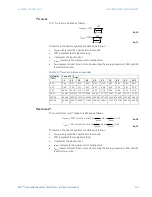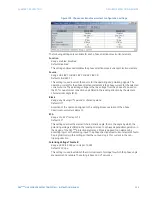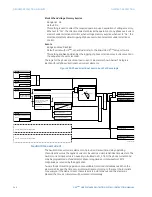
CHAPTER 7: PROTECTION
GROUPED PROTECTION ELEMENTS
D90
PLUS
LINE DISTANCE PROTECTION SYSTEM – INSTRUCTION MANUAL
225
Ground directional overcurrent guidelines for protecting series compensated lines
The ground directional overcurrent function (negative-sequence overcurrent or neutral
overcurrent) uses an offset impedance to guarantee correct fault direction discrimination.
The following setting rules apply.
1.
If the net impedance between the potential source and the local equivalent system is
inductive, then there is no need for an offset. Otherwise, the offset impedance shall be
at least the net capacitive reactance.
2.
The offset cannot be higher than the net inductive reactance between the potential
source and the remote equivalent system. For simplicity and extra security, the far-
end busbar may be used rather than the remote equivalent system.
As the ground directional functions are meant to provide maximum fault resistance
coverage, it is justified to assume that the fault current is very low and none of the series
capacitors is guaranteed to get by-passed. Consider settings of the negative-sequence
directional overcurrent protection element for the sample series compensated system.
For the sending bus relay, bus-side VTs.
1.
The net inductive reactance from the relay into the local system is –2
Ω
+ 3
Ω
= 1
Ω
> 0.
There is no need for offset.
2.
The net inductive reactance from relay through far-end busbar is –4
Ω
+ 10
Ω
– 3
Ω
= 3
Ω
. The offset cannot be greater than 3
Ω
.
3.
Therefore, it is recommended to use a 1.5
Ω
offset impedance.
For the sending bus relay, line-side VTs.
1.
The net inductive reactance from relay into local system is –2
Ω
+ 3
Ω
– 4
Ω
= –3
Ω
< 0.
An offset impedance
≥
3
Ω
must be used.
2.
The net inductive reactance from relay through far-end busbar = 10
Ω
– 3
Ω
= 7
Ω
. The
offset cannot be greater than 7
Ω
.
3.
Therefore, it is recommended to use a 5
Ω
offset impedance.
For the receiving bus relay, bus-side VTs.
1.
The net inductive reactance from relay into local system is –5
Ω
+ 7
Ω
= 2
Ω
> 0. There
is no need for offset.
2.
The net inductive reactance from relay through far-end busbar is –3
Ω
+ 10
Ω
– 4
Ω
=
3
Ω
; the offset cannot be greater than 3
Ω
.
3.
Therefore, it is recommended to use a 1.5
Ω
offset impedance.
For the receiving bus relay, line-side VTs.
1.
The net inductive reactance from relay into local system is –3
Ω
– 5
Ω
+ 7
Ω
= –1
Ω
< 0.
An offset impedance
≥
1
Ω
must be used.
2.
The net inductive reactance from relay through far-end busbar is 10
Ω
– 4
Ω
= 6
Ω
. The
offset cannot be higher than 6
Ω
.
3.
Therefore, it is recommended to use 3.5
Ω
offset impedance.
High-set overcurrent guidelines for protecting series compensated lines
Especially at low SIR values, fast fault clearance times may be seen as extremely
important, from both system stability and equipment damage viewpoints. The high-set
overcurrent element, when set appropriately, can be extremely useful in achieving these
goals. It helps the setting calculations if the system impedances are reasonably well
known.
The overcurrent pick up should be set to the greater of the following values.
•
The maximum infeed seen by the D90
Plus
, for a close in reverse fault.
•
The maximum fault level seen by the D90
Plus
for a fault at 100% of the protected line.






























